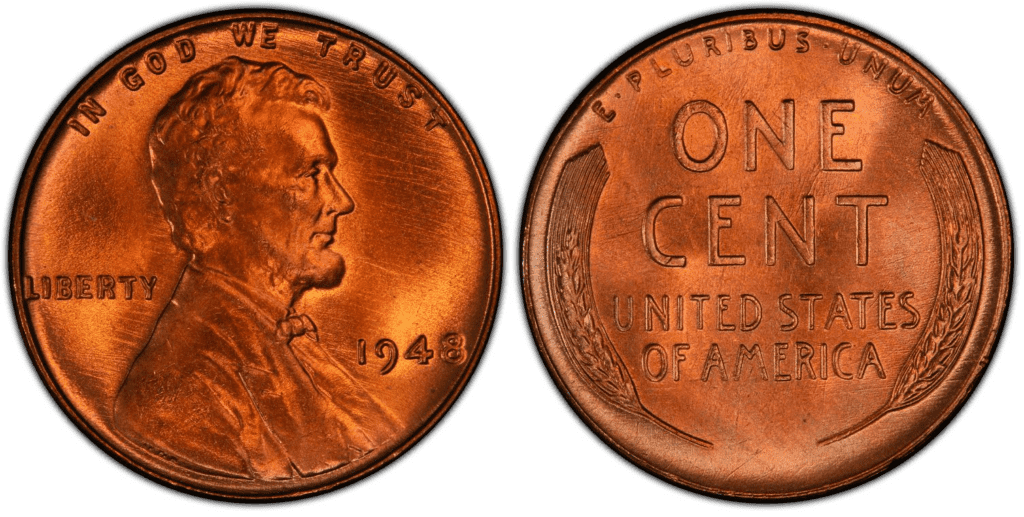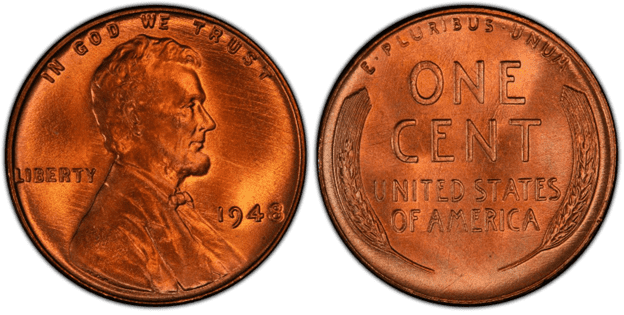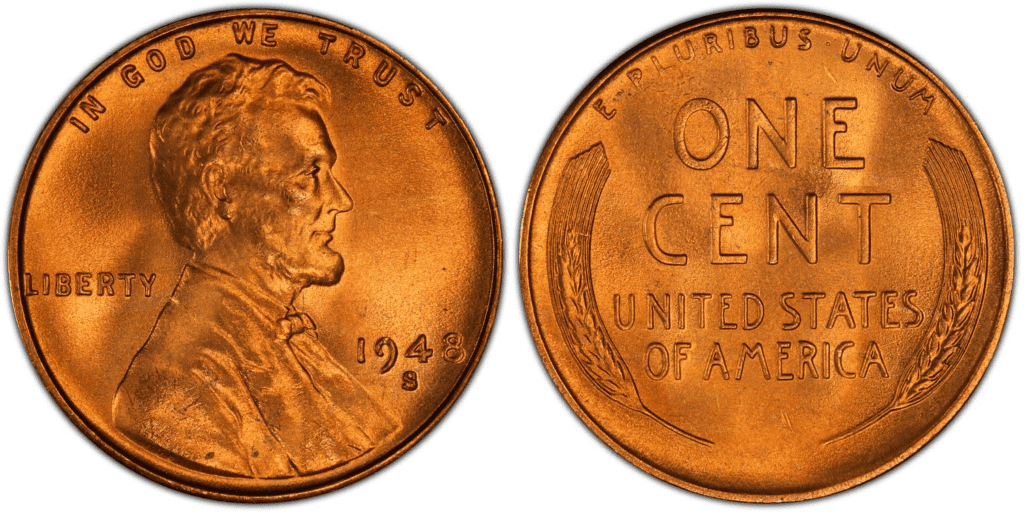The wheat penny obtained its name from the two stalks of wheat on its reverse side. What’s interesting about the wheat penny is it also features one of the most loved presidents of the United States, Abraham Lincoln.
What’s more interesting is that since its first release, there have been billions upon billions of pennies produced. Something that’s not surprising since the penny is the smallest coin denomination in the US.
Perhaps, one of the biggest questions most people have is this, “What is the 1948 wheat penny made of?” The answer is that this penny is made of 95% copper and 5% tin and zinc. Copper is no doubt a common base metal used in coinage. Other US coins also have copper.
You need to know that the wheat penny isn’t always copper. In 1943, it was made with zinc-plated steel.
The Wheat Lincoln penny first appeared in 1909. Victor David Brenner designed both the obverse and reverse sides of the coin. When the Lincoln penny was first released, the reverse came with the wheat design.
However, the reverse was changed in 1959 into the world-famous Lincoln Memorial. At this time, it was Frank Gasparro who designed the reverse.

Going back to the 1948 wheat penny, you’ll find the image of the sixteenth US president facing to the right on the obverse. He is accompanied by inscriptions, including IN GOD WE TRUST, LIBERTY, and 1948.
On the reverse, there are two stalks of wheat. Inscriptions include ONE CENT, UNITED STATES OF AMERICA, and E PLURIBUS UNUM.
1948 Lincoln Wheat Penny Varieties
The US minted three varieties, which include 1953-D, 1953-P, and 1953-S. Three Mint Centers also worked together to produce more than 571 million pennies. Here’s a breakdown of penny production in 1948:
| Mint Center | Type | Mintage |
| Denver | Regular strike | 172,637,500 |
| Philadelphia | Regular strike | 317,570,000 |
| San Francisco | Regular strike | 81,735,000 |
| Total | 571,942,500 |
While this number can be impressive, it is a low mintage compared to the years before 1948. For example, in 1945, the Philadelphia Mint alone produced more than a billion pennies. One reason for the decrease in production is that the US went through economic difficulties in 1948, forcing the US mint to reduce output.
With all that said, here’s a list of the 1948 Lincoln wheat penny varieties that you should know:
1948 D Lincoln Penny
Edge: Plain
Mint Mark: D
Place of minting: Denver
Year of minting: 1948
Face Value: $0.01 (one cent)
Price: $0.15 to $19 (or more)
Quantity produced: 172,637,500
Designer: Victor David Brenner
Composition: 95% Copper and 5% Tin and Zinc
Mass: 3.11 grams
Diameter: 19.05 mm

photo source: PCGS
The Denver mint produced more than 170 million wheat pennies. Price may range from $0.15 to $19. Because of its mass quantity, you should easily find 1948-D pennies in most grades. MS64 is fairly common, and they are affordable. MS65 should also be available but more challenging to find than MS64. MS66 becomes more expensive, and anything higher becomes scarce.
1948 P Lincoln Penny
Edge: Plain
Mint Mark: No mintmark
Place of minting: Philadelphia
Year of minting: 1948
Face Value: $0.01 (one cent)
Price: $0.50 to $9 (or more)
Quantity produced: 317,570,000
Designer: Victor David Brenner
Composition: 95% Copper and 5% Tin and Zinc
Mass: 3.11 grams
Diameter: 19.05 mm

photo source: PCGS
The Philadelphia Mint, with its variety, the 1948-P, produced the most pennies in 1948. All in all, the Mint produced more than 317 million 1-cent coins. The price of this coin may range from $0.50 to $9. If your coin is rare or in excellent condition, you may be able to sell it for a higher price.
The 1948-P wheat penny may be easy to find up to MS64. However, MS65 and higher grades are very difficult to find. MS67-graded 1948 pennies are even scarcer. Some estimate that there are only 10 pieces of these pennies today.
1953 S Lincoln Wheat Penny
Edge: Plain
Mint Mark: S
Place of minting: San Francisco
Year of minting: 1948
Face Value: $0.01 (one cent)
Price: $0.50 to $17 (or more)
Quantity produced: 81,735,000
Designer: Victor David Brenner
Composition: 95% Copper and 5% Tin and Zinc
Mass: 3.11 grams
Diameter: 19.05 mm

photo source: PCGS
Regrettably, the San Francisco Mint used overly polished and worn dies when they produced 1948 wheat pennies. But, of course, no one can blame them, as this year was when the US Mint needed to tighten its belts.
Because of this, there are a lot of 1-cent coins from the San Francisco Mint that show poor details. Although the Mint produced proof like pennies, this only happened briefly when they had just polished the overly worn dies.
That said, the San Francisco Mint produced more than 80 million pennies. As a result, 1948-S pennies may sell at $0.50 to $17.
List Of 1948 Lincoln Penny Errors
In 1948, the U.S. Mint made over 570 million Lincoln Wheat Penny for circulation. With this considerable mintage, you can imagine how the minting equipment was overworked. Because of that, some errors would have happened during the minting process.
There were different types of penny errors in 1948, which are also common to other coins. An example would be the planchet error. This error occurs when the planchet or coin is being cut. The cutting was faulty and can cause a clipping or fold on the coin’s edge.
Here’s an example of a 1948 Lincoln penny with a clipped planchet:
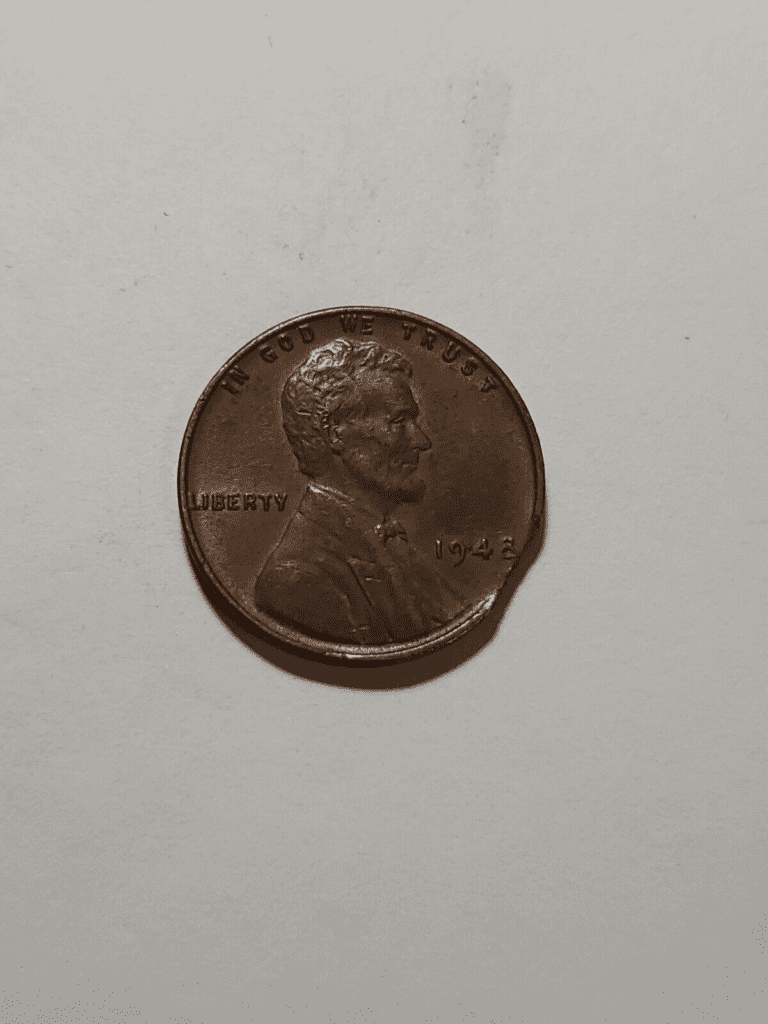
There are times when during the creation of the planchet, there are foreign materials or air bubbles that get stuck in the metal coin. Then, when the coin cooled down, the foreign material caused the coin to chip off or crack.
Here’s an example of a lamination error:
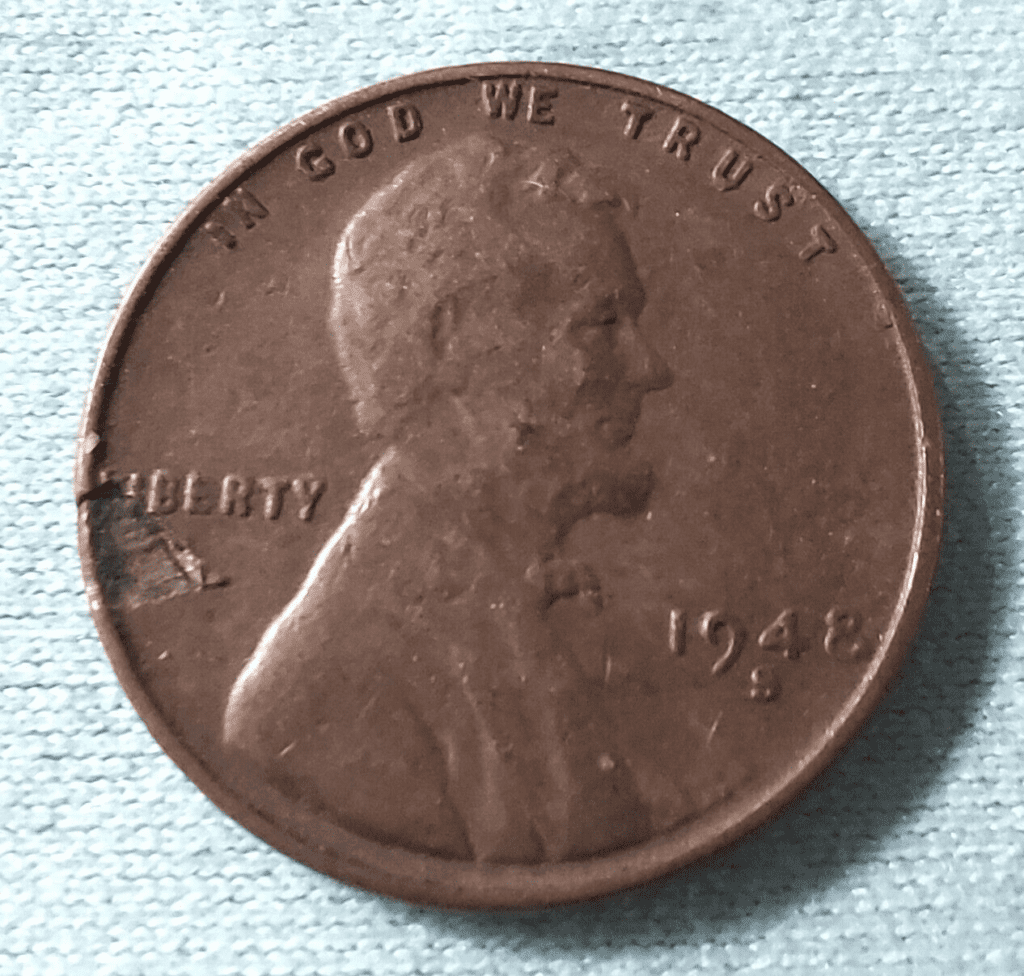
Aside from planchet errors, you also have strike errors. These errors happen precisely when the die strikes the planchet. Sometimes, the strike becomes off-center. The off-center strike can be off for a small degree, or it can be considerable.
Here’s a slight off-center error that caused the letter “L” in Liberty to touch the rim of the coin:
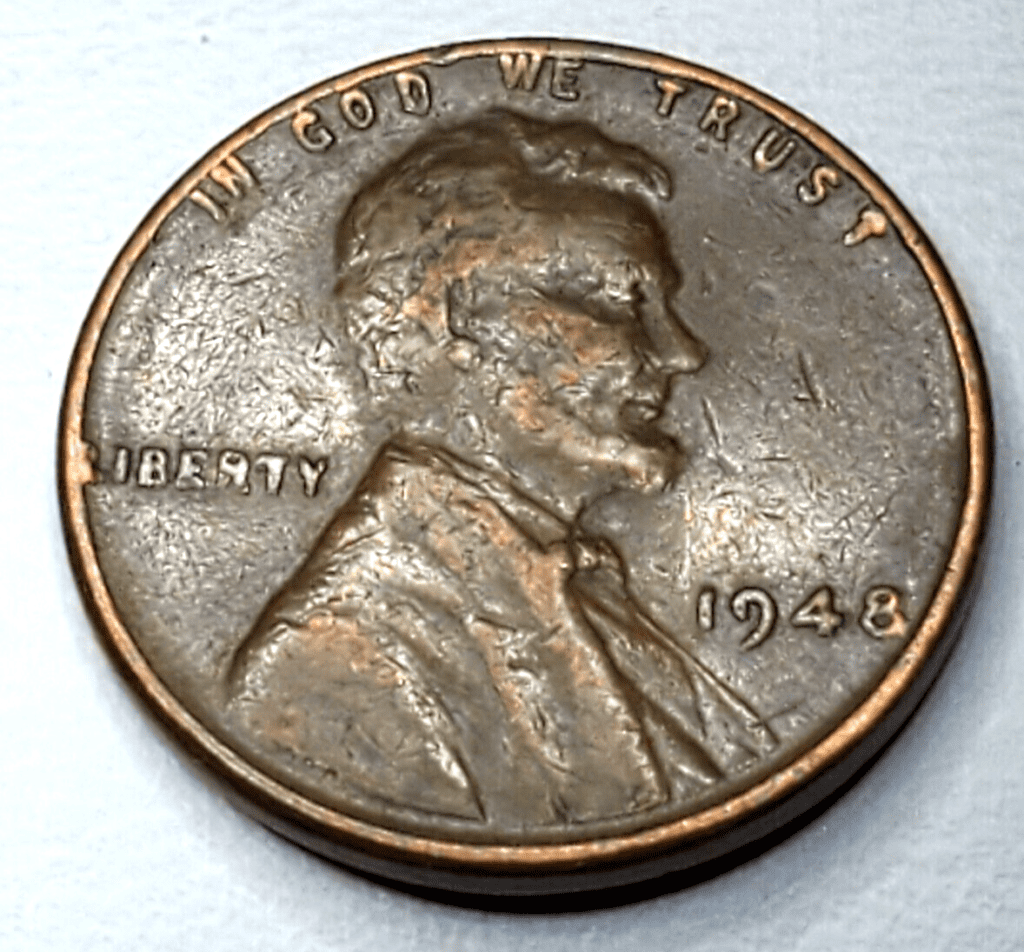
These are just some examples of penny coin errors in 1948. While they may look odd or ugly, error coins are fascinating to numismatists. Some error coins are even more valuable than mint coins.
How Much Is The 1948 Lincoln Wheat Penny Worth Today?
The 1948 Lincoln wheat penny has a face value of $0.01. But, unfortunately, its melt value isn’t that much at $0.0252. Thus, if you rely on the face value and melt value of the 1948 Lincoln penny, you won’t earn much from it.
However, you would be surprised to know that there are Lincoln pennies that are astronomically more valuable than their face value or melt value.
Take a look at this 1948 Lincoln Wheat Penny values chart to see how some 1948 1-cent coins are so much more valuable:
| Coin | Condition | Grade | Mintage | Value |
| 1948 D Lincoln penny | Circulated/Mint | Not graded | 172,637,500 | $0.15 to $0.20 |
| 1948 D Lincoln penny | Uncirculated/Mint | MS-65 | 172,637,500 | $9 to $17 |
| 1948 D Lincoln penny | Uncirculated/Mint | MS-66 | 172,637,500 | $15 to $55 |
| 1948 D Lincoln penny | Uncirculated/Mint | MS-67 | 172,637,500 | $288 to 625 |
| 1948 P Lincoln penny | Circulated/Mint | Not graded | 317,570,000 | $0.15 to $0.20
|
| 1948 P Lincoln penny | Uncirculated/Mint | MS-65 | 317,570,000 | $7 to $190 |
| 1948 P Lincoln penny | Uncirculated/Mint | MS-66 | 317,570,000 | $61 to $180 |
| 1948 P Lincoln penny | Uncirculated/Mint | MS-67 | 317,570,000 | $780 to $1,800 |
| 1948 S Lincoln penny | Circulated/Mint | Not graded | 81,735,000 | $0.15 to $0.20
|
| 1948 S Lincoln penny | Uncirculated/Mint | MS-65 | 81,735,000 | $7 to $22 |
| 1948 S Lincoln penny | Uncirculated/Mint | MS-66 | 81,735,000 | $17 to $43 |
| 1948 S Lincoln penny | Uncirculated/Mint | MS-67 | 81,735,000 | $91 to $264 |
Now that you have seen how some wheat pennies were sold for a lot of money wait until you see the auction records for each variety. Check out this list:
- $10,350 – a 1948 1C, RD (Regular Strike) coin with a grade of MS67 sold in January 2012 by Heritage Auctions
- $3,000 – a 1948-D 1C, RD (Regular Strike) coin with a grade of MS67+RD sold in January 2022 by Heritage Auctions
- $1,998 – 1948-S 1C, RD (Regular Strike) with a grade of MS67+ sold in August 2014 by Heritage Auctions
How Does The Grading System Work?
The Sheldon Scale is used by numismatists to provide a numerical value to coins. The Sheldon Scale goes from poor (P-1) to perfect mint state (P-1) (MS-70). Coins were originally evaluated using words to reflect their condition (Good, Fair, Excellent, Etc.). Unfortunately, coin collectors and dealers had different ideas about what each of these terms represent.
Professional numismatists joined together in the 1970s and established CoinGrading standards. These numismatists now assign grades at key places on the seventy-point scale, using the most regularly utilized numeric points in conjunction with the original adjective grade. The following are the most common coin grades:
-
-
- (P-1) Poor – Indistinguishable and probably damaged; if used, must have a date and mintmark; otherwise, rather battered.
- (FR-2) Fair – Nearly smooth, but without the damage that a coin graded Poor often possesses. The coin must have enough detail to be identified.
- (G-4) Fair – Inscriptions have merged into the rims in some areas, and important elements have been mostly erased.
- (VG-8) Very Good- A little weathered, but all of the primary design elements are visible, albeit faintly. There is little if any, central detail left.
- (F-12) Good – The item is very worn, yet the wear is even, and the overall design details stand out clearly. Rims are almost completely isolated from the field.
- (VF-20) Very Fine – Moderately weathered, with some finer features still visible. The motto or all letters of LIBERTY are readable. Both sides of the coin have entire rims that are separated from the field.
- (EF-40) Extremely Fine – Gently used; all gadgets are visible, and the most important ones are bold. The finer details are bold and clear, however, light wear may be seen.
- (AU-50) Uncirculated – Slight evidence of wear on the coin’s design’s high points; may have contact marks; eye appeal should be adequate.
- (AU-58) Uncirculated Choice – Slight traces of wear, no severe contact marks, almost full mint shine, and great eye appeal.
- (MS-60) Mint State Basal – Strictly uncirculated; no indication of wear on the coin’s highest points, but an unsightly coin with reduced luster, visible contact marks, hairlines, and other flaws.
- (MS-63) Mint State Acceptable – Uncirculated, but with contact scratches and nicks, little reduced shine, but otherwise appealing appearance. The strike is weak to average.
- (MS-65) Mint State Choice – Uncirculated with great mint shine, very little contact blemishes, and exceptional eye appeal. The strike is unusually severe.
- (MS-68) Mint State Premium Quality – Uncirculated with superb luster, no obvious contact marks to the naked eye, and exceptional eye appeal. The strike is quick and appealing.
- (MS-69) Almost Perfect Mint State – Uncirculated with perfect brilliance, a sharp and appealing strike, and extremely good eye appeal. A near-perfect coin with minor imperfections in the planchet, strike, and contact markings (seen only under 8x magnification).
- (MS-70) Mint State Perfect – Under 8x magnification, there are no tiny imperfections discernible; the strike is crisp, and the coin is perfectly centered on a beautiful planchet. Rarely seen on a coin, this coin is bright and whole, with original luster and exceptional eye appeal.
-
Where To Buy Or Sell 1948 Lincoln Wheat Penny?
You can buy and sell 1948 Lincoln wheat pennies in different places. If you want to see the coins you want to buy physically, you can visit coin shops, pawnshops, or antique stores. Auction houses also host a lot of great wheat pennies, both rare and in top-notch condition.
Of course, living in the digital age, the quickest way for you to sell and buy 1948 Lincoln pennies would be on the Internet. Just be aware that there are a lot of scammers online. So, be careful. Only work with reputable and trusted parties.
eBay is the most popular online platform where you can buy and sell coins. You can also try Amazon and Etsy, although their listing is smaller than eBay’s.
You can go to social media platforms and search. For example, Facebook has Marketplace where people who want to sell something go. Perhaps, you’ll be able to find 1948 Lincoln pennies there.
Joining clubs and groups of coin collectors should also help. The more people you know, the more chances you’ll have to find the right coin.
FAQs
What is a 1948 D mint wheat penny worth?
The 1948 D mint wheat penny is only worth 1 cent. However, since this is an old coin and because of its sentimental or numismatic value, it could be worth more. To give you an idea, a 1948-D 1C RD with a grade of MS67+RD was sold for $3,000 during an auction held by Heritage Auctions in January 2012.
How much is a 1948 wheat penny worth without a mint mark?
The 1948 wheat penny without a mint mark, also known as 1948-P, is worth $0.01. The face value is small, but this coin can be sold for more if it is rare and still in good condition. For example, a 1948 1948-P coin with a grade of MS67 was sold for $10,350 in January 2012 by Heritage Auctions.
What makes a 1948 wheat penny rare?
The 1948 wheat penny becomes rare when it is still in good condition. For example, a 1948-P penny with at least an MS-67 grade is considered rare because only a few of them are known to have existed today.

